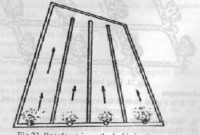The field is divided into a number of long parallel (3-10 ni x 50-30() m) strips which is called border. The border is separated with small parallel low ridges on the sides. The individual strips are levelled perfectly and each strip is irrigated independently by turning a stream of water at the upper elevation. The water can flow down the slope with nearly uniform depth.
This method is suitable to irrigate all close growing crops like wheat, barley, fodder crops and legumes. But this method is not suitable to irrigate rice which requires standing water during most part of their growing season. This method is suitable to soils having moderately low to moderately high infiltration rate.

Advantages/Pros/Benefits of Border Strip Irrigation System:
- It is the best method to irrigate close growing crops.
- Uniform distribution and high water application efficiencies are possible if the system is properly designed.
- Labour requirement is less to irrigate the field.
- Operation of this system is simple and easy.
- Excess rainwater is drained out if outlets are available.
Disadvantages/Cons/Drawbacks of Border Strip Irrigation System:
- More labour is required for leveling of the field.
- Ridges cut down the neat cropped area.
- Large irrigation streams are required.
- Repair of ridges and supervision during irrigation are needed.
